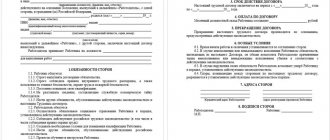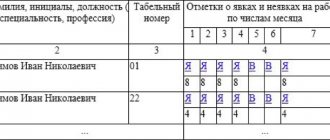When applying for employment at any enterprise (be it a state, budgetary institution or private enterprise, such as an LLC or individual entrepreneur), a certain agreement is always concluded between the employer and the candidate for the position, which stipulates:
- details of the employer (name of the organization, position of the representative of the organization, last name, first name and patronymic of the representative of the organization. As a rule, they are the head or general director, or a personnel specialist of the employer's organization. The legal address, tax identification number and contact information of the organization are indicated.);
- employee details (last name, first name, patronymic, registration address, residential address, identity document details, contact information, TIN if available);
- date and place of conclusion of this agreement (the name of the locality is sufficient, it is not necessary to indicate a specific address);
- signatures of participants.
If one of these details is not included in the contract, then it can be considered invalid. Particular attention must be paid to the date of signing the contract. If it is not specified at all, then the contract will not come into force, but setting it retroactively, if for some reason it was not set on time, is strictly prohibited. This must be done directly on the day of signing. It is not necessary to sign the contract before starting work. This can be done already during the cooperation process, but no later than three days from the start of work.
It is important to know that this document must be drawn up in two copies for each participant. And each copy must be signed by both participants. These facts are considered known and understandable to all parties to the contract, but both the employer and the employee are often interested in the question of the need to affix a seal to the employment contract.
Lawyer's answer
In connection with the requirement of Article 16 of the Labor Code of the Russian Federation (hereinafter referred to as the Labor Code of the Russian Federation), when applying for a job, it is necessary to conclude an employment contract.
An employment contract is concluded in writing by bilateral signing by a representative of the employer and the employee himself (Article 67 of the Labor Code of the Russian Federation).
Expert opinion
Kuzmin Ivan Timofeevich
Legal consultant with 6 years of experience. Specializes in the field of civil law. Member of the Bar Association.
The current legislation does not provide for a standard (unified) form of an employment contract. Therefore, the employer has the right to develop and apply his own form of employment contract.
The law (Article 57 of the Labor Code of the Russian Federation) contains only instructions on the mandatory details and mandatory conditions that must be specified in the employment contract.
Mandatory details of an employment contract include:
- last name, first name, patronymic of the employee and name of the employer;
- surname, initials of the tenant’s representative and the basis document giving him the authority to sign the agreement on behalf of the tenant;
The Labor Code does not provide for such a mandatory requisite of an employment contract as a seal and does not contain instructions that a seal must be affixed to an employment contract.
Placing a seal is an additional requisite used at the request of the parties.
Consequently, the Labor Code of the Russian Federation does not require affixing a seal to employment contracts.
Failure to affix the organization's corporate seal to an employment contract is not a violation of current legislation, so a fine cannot be imposed for it.
Printing as a business custom
As we can see, such details of an employment contract as the employer’s seal are not provided for by the Labor Code. This means that its absence does not make the document legally invalid.
Indirectly, this conclusion can be drawn on the basis of Part 1 of Art.
61 Labor Code of the Russian Federation. It states that the employment contract comes into force from the day it is signed by the employee and the employer, unless otherwise provided by other regulatory legal acts or the employment contract, or from the day the employee is actually admitted to work with the knowledge of the manager.
There is no mention of the employer's seal here.
Therefore, in the situation under consideration, we can only talk about the established business custom of certifying the signatures of officials on employment contracts with a seal.
Signatures of the parties
At the end, after all points, the signatures of the parties must be placed: the employee and the employer. Without them, the contract is invalid.
In accordance with Art. 61 of the Labor Code of the Russian Federation, the agreement comes into force from the moment of signing, unless other terms are established by its provisions. If it does not indicate the start date of work, the employee must go to work not on the day of conclusion, but on the next day. If this requirement is not met, the employer has the right to cancel the agreement, however, the provision of compulsory insurance will be valid from the date of registration until cancellation.
Signatures of the parties are sufficient
According to Part 1 of Art. 67 of the Labor Code of the Russian Federation, an employment contract is concluded in writing, drawn up in two copies, each of which is signed by the parties. Therefore, if the document does not have a seal, but there are signatures of authorized persons, this clearly confirms the fact that an employment relationship has arisen.
In conclusion, we note that the approximate forms of the employment contract recommended for employers for use when registering labor relations with employees, Resolution of the Ministry of Labor of the Russian Federation dated July 14, 1993 N 135 and Resolution of the Ministry of Labor and Social Development of the Russian Federation dated July 23, 1998 N 29, also do not provide for of the employment contract, places for affixing a stamp. These regulatory documents are still applied to the extent that they do not contradict current labor legislation.
The absence of one of these details is grounds for recognizing the contract as an invalid document.
Opinion of lawyers and auditors on the use of seal
Lawyers recommend that employers put a stamp on the employment contract so that the employee or his representative does not have questions about the legality of the signature. This especially applies to situations when it is not entered by the head of the company, but by another authorized person (for example, the head of the personnel department).
Some auditors also make a comment when there is no seal on employment contracts. In this case, we are not talking about the obligation of the employer established by current legislation, but a legal custom in the field of labor law. A serious violation is the use of a “simple” seal (for example, the personnel department), and not the company seal.
The company seal has a round shape; it indicates the company name of the organization and its location. In some cases, the imprint contains an abbreviated name of a legal entity, a trademark, or other means used for individualization.
“Simple” seals include seals of personnel and other departments of the organization. They can be made in the shape of a corner, triangle, etc.
Watch a video that will tell you whether a seal is needed on the contract
Using printing in documentation
A stamp is a mechanical device that makes an impression with the details of an organization. The purpose of the imprint is to certify the signature affixed by the manager. The seal is stored in organizations in special places, and a limited number of persons have access to it.
There is documentation that is not considered fully completed if it does not have the company’s seal on it.
Such documentation includes:
- Forms that grant certain rights to third parties.
- Papers that have a financial purpose.
- Other forms that contain the signature of the head of the enterprise and require certification of its authenticity.
Based on these criteria, it is easy to see that most documents do not require an imprint, but legal entities try to make the most of the available imprint in order to further protect themselves and the organization from possible falsification.
Stamping on the employment order and copies of personnel documents
The employment order is issued by the employer after the parties have signed the employment contract. It refers to internal administrative documents, so it is also not stamped.
Expert opinion
Kuzmin Ivan Timofeevich
Legal consultant with 6 years of experience. Specializes in the field of civil law. Member of the Bar Association.
Thus, an employment contract is valid even if there is no seal certifying the signature of the employer’s representative. If it is used when concluding an agreement with an employee, then it is necessary to affix a round seal.
Information about the parties to the agreement and the documents on the basis of which they act
Information about these parties is a mandatory item. Here the full name of the employed employee, the name of the employing organization, the full name and position of the person signing the contract on his behalf are indicated.
If the employer is an individual entrepreneur, his status and full name are indicated; if an individual - full name. It is not necessary to indicate the employee’s passport details in the preamble of the contract if they are indicated in the section with the details of the parties. It is necessary to indicate information about the document on the basis of which the employer acts.
Don't know your rights? Subscribe to the People's Adviser newsletter. Free, one minute to read, once a week.
If the employer is a company, such documents are:
- for the head of the organization - the charter;
- for another employee - a power of attorney (indicate its number, if any, date of issue, expiration date).
Signing employment contracts is a representation (Chapter 10 of the Civil Code of the Russian Federation). You cannot sign this type of document on the basis of an order to replace a manager or simply on the basis that his job responsibilities include such a function. A power of attorney is required.
For individual entrepreneurs and individuals, passport data and TIN are indicated.
Is there a stamp on the employment contract?
The Labor Code regulates the legal issues of concluding contracts and establishes that this document must be drawn up in two copies. According to Article 67 of the Labor Code of the Russian Federation, each copy must have two signatures - the employee and the employer. From the moment the agreement is signed by both parties, it comes into full force.
The legislation regarding the conclusion of contracts does not stipulate the need for a seal. Is a seal required on an employment contract if this fact is not regulated by the Labor Code?
Using a seal on an employment contract in practice
Additional facts
It is important that the seal in the employment contract does not give the document legal force - it confirms the authenticity of the official’s signature on financial and other documents that require certification of the original signature (clause 3.25 of GOST R 6.30-2003).
The fact that an employment contract without a seal has no legal force is not mentioned in any of the articles of the Labor Code of the Russian Federation. However, it can be affixed at the request of the parties, acting as a requisite confirming the authenticity of the signature of the employer’s representative.
In accordance with the law, the organization's seal must be affixed to:
- On documents serving as evidence of the rights of third parties;
- On papers recording facts directly related to the disposal of financial amounts;
- On other documents where it is necessary to verify the signature of an official.
This list also makes no mention of the need to affix a seal on the employment contract. Despite this, in most cases, in practice, it is placed on all documents, including not only the agreement between the employee and the employer, but also the amendments attached to it.
Read about extending a fixed-term employment contract here.
Parties' details
Each contract must begin with clarification of information about who exactly enters into the employment relationship.
Employment agreements always involve two sides of interaction:
- An individual, namely an employee hired for a position. The preamble contains his last name, first name and patronymic in Russian; information is taken from the passport for correctness.
- Entity. Since the organization itself cannot represent its interests, a person is always appointed who is entrusted with this mission. Usually this is the head or general director of the enterprise. When specifying information about him, you should write his position, then the name of the organization and only then his full name.
Please note that it is unacceptable to enter the information of the organization rather than the manager in the “employer” column.
Document information
Information about the employee and employer must be supported by documents. For an individual, the identification document is a passport. The passport can be of the Russian Federation or another state. The agreement includes information about what document identifies the employee, its series and number, when and by whom it was issued.
It is also important for the employer's representative to provide documentary evidence of his authority. It can be expressed in two documents:
- Charter of the enterprise.
- A power of attorney issued to the manager to perform functions.
If the organization’s Charter states that all representative functions are performed by the director, then the agreement provides a reference to this document. If you have a power of attorney, you must indicate its number and expiration date. Be careful, it is not the date of issuance of the power of attorney that is stated, but the expiration date of its term.
Mandatory details of the employment contract
An employment contract is a special form of document that establishes the legal relationship between the two parties to cooperation. It is concluded when hiring a new employee. The agreement must take into account the smallest details, therefore, although the legislation does not have developed forms for writing them, it regulates the information that should be included in it.
Article 57 of the Labor Code of the Russian Federation contains an exhaustive list of what must be stipulated in the contract. It also indicates what the approximate type of document should be, namely how the preamble and the final part of the form are drawn up.
In addition to the mandatory points, the agreement may also include other clauses that can be an important addition.
The completeness of the points and their content depends on what kind of agreements were reached by the parties, but there are some points that cannot be avoided. These include information about the parties to future cooperation, the date of signing the agreement, details of the employee and employer.
Parties' details
Each contract must begin with clarification of information about who exactly enters into the employment relationship.
Employment agreements always involve two sides of interaction:
- An individual, namely an employee hired for a position. The preamble contains his last name, first name and patronymic in Russian; information is taken from the passport for correctness.
- Entity. Since the organization itself cannot represent its interests, a person is always appointed who is entrusted with this mission. Usually this is the head or general director of the enterprise. When specifying information about him, you should write his position, then the name of the organization and only then his full name.
Please note that it is unacceptable to enter the information of the organization rather than the manager in the “employer” column.
Document information
Information about the employee and employer must be supported by documents. For an individual, the identification document is a passport. The passport can be of the Russian Federation or another state. The agreement includes information about what document identifies the employee, its series and number, when and by whom it was issued.
It is also important for the employer's representative to provide documentary evidence of his authority. It can be expressed in two documents:
- Charter of the enterprise.
- A power of attorney issued to the manager to perform functions.
If the organization’s Charter states that all representative functions are performed by the director, then the agreement provides a reference to this document. If you have a power of attorney, you must indicate its number and expiration date. Be careful, it is not the date of issuance of the power of attorney that is stated, but the expiration date of its term.
Taxpayer identification number
A taxpayer identification number is a convenient tool for systematizing tax payments and the ability to track the history of their implementation. For legal entities, obtaining a TIN is a necessity that they cannot do without, which is why each organization has this individual number.
An individual may, at his discretion, contact the tax department at his place of registration and receive his TIN absolutely free of charge. Since this measure is not mandatory, not all taxpayers bothered to receive it.
Therefore, for an organization, the TIN must be indicated, and for an individual, only if it is available.
Place and date of conclusion
Another mandatory point is to indicate the place and date of the contract. The place means the city in which the enterprise is located; it should not be specified in more detail; there are other clauses in the agreement for this.
Without indicating the date of signing the document, the contract will generally be considered void, so do not forget about this small nuance. The date is the day on which the agreement is signed by the parties. However, the date may not always precede the start of work; in some cases, the contract is signed after the employee has begun to perform his duties. The Labor Code allows you to draw up an agreement after the employee has started working, but no later than three working days from the moment he assumes his direct duties.
Contracts cannot be concluded in the past; the date must always correspond to real time.
Signatures of the parties
The document must be completed by signing; it is this action that puts it into effect and makes it official.
To register the place of signatures of the accepted employee and employer, it is customary to write down detailed addresses of the parties. For an organization, a legal address is indicated, and for an individual, two masses can be registered at once - registration and actual residence, provided that he does not live at his place of registration. Contact numbers are also indicated here. Detailed details of the organization may be specified. Below this information are the full names of the parties, next to which they affix their signatures.
Taxpayer identification number
A taxpayer identification number is a convenient tool for systematizing tax payments and the ability to track the history of their implementation. For legal entities, obtaining a TIN is a necessity that they cannot do without, which is why each organization has this individual number.
An individual may, at his discretion, contact the tax department at his place of registration and receive his TIN absolutely free of charge. Since this measure is not mandatory, not all taxpayers bothered to receive it.
Therefore, for an organization, the TIN must be indicated, and for an individual, only if it is available.
Basic Concepts
An employment contract is a type of agreement provided for by the Labor Code (hereinafter also referred to as the Code) between an employee and an employer on key points of the work process. The document establishes the rights and obligations of the parties, determines the result obtained by the organization, and the payment due to the specialist hired.
It is important to know! Citizens acquire legal capacity to enter into contractual relations with employers from the age of 16 years. The contract is in a free form, which specifies mandatory and additional conditions.
The agreements of the parties are sealed with the signatures of the general director (other authorized employee) and the employee. The seal on the employment contract is used to certify the signature of the official. As a rule, this is the stamp of the organization, but a number of companies have a separate stamp for personnel documents.
The basis of legislation on the conclusion of written employment agreements is laid down in Chapter III of the Code. Explanations on certain issues relating to the relationship between employees and employers are contained in letters from federal executive authorities authorized in the relevant area (Ministry of Labor and Rostrud of Russia).
When labor disputes arise, judges are guided by previously adopted decisions of colleagues in similar cases, in order to maintain uniformity of law enforcement practice.
The Labor Code regulates the legal issues of concluding contracts and establishes that this document must be drawn up in two copies. According to Article 67 of the Labor Code of the Russian Federation, each copy must have two signatures - the employee and the employer. From the moment the agreement is signed by both parties, it comes into full force.
The legislation regarding the conclusion of contracts does not stipulate the need for a seal. Is a seal required on an employment contract if this fact is not regulated by the Labor Code?
Is a seal required in an additional agreement?
Federal Law. Labor Code of the Russian Federation may also be individuals who are not individual entrepreneurs, who are not required to have a seal by any norm of law. Thus, it is not necessary to affix a seal to an employment contract. Let us note that specialists in the field of personnel records management have a different point of view, according to which the organization's seal on personnel documents is necessary in cases where the document formalizes any mutual rights and obligations of the employer and employee, in particular when concluding an employment contract (see, for example, Yu.E. Romanova, “When do you need to put a seal?”, “HR service and personnel management of an enterprise”, N 3, March 2007; Vasiliev M.V., “HR administration: how to avoid mistakes” - M.: “Tax Bulletin”, 2011). To substantiate their position, these experts refer to the standards of GOST R 6.30-2003 “Unified documentation systems.
Conditions for the mandatory presence of a seal on documents
There is a dual opinion here. If we rely on the legislative framework of the Russian Federation, then a seal must be affixed to financial documents, documents establishing the rights of the parties, and other documents where it is necessary to confirm the signature of an authorized person with a seal.
However, most employers still stamp most documents, including the employment contract. They do this primarily to reassure the employee, as well as to minimize the possibility of fraudulent activities and various labor disputes, since the seal in these cases is an additional confirmation of the signature of the authorized person of the organization.
This is not prohibited by law, and when checking an organization’s documentation, employees of auditing companies will not be able to consider the presence of a seal on such documents a violation.
However, there are some subtleties here too, since organizations have a number of seals.
Is it necessary to put a stamp on the additional agreement?
But, at the same time, such amendments were not made to the by-laws, which provided for the mandatory use of the seal. Is it necessary to put a stamp on an additional agreement to an employment contract? Only certain norms of various areas of legislation (civil, tax, etc.) require documents to be sealed in specific situations (see, for example, paragraph 5 of Article 185, paragraph 1 of Art. 160 of the Civil Code of the Russian Federation, Article 93 of the Tax Code of the Russian Federation, Instruction of the Central Bank of Russia dated September 14, 2006 N 28-I “On opening and closing bank accounts, deposit accounts”). At the same time, for example, in civil legal relations in accordance with paragraph three of paragraph 1 of Art. 160 of the Civil Code of the Russian Federation, sealing transactions (including contracts - clause 1 of Article 154 of the Civil Code of the Russian Federation) is necessary only in cases directly established by law. In labor relations, neither the above Art.










